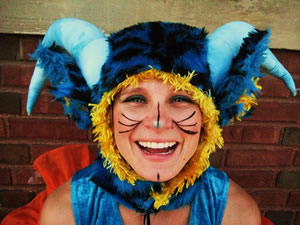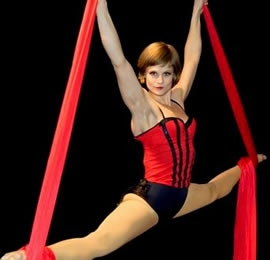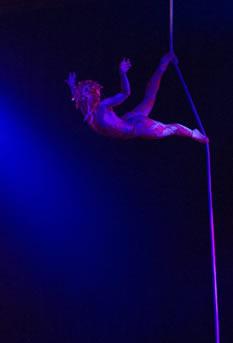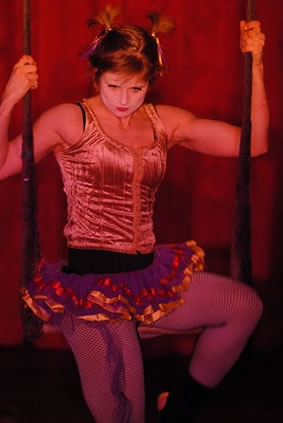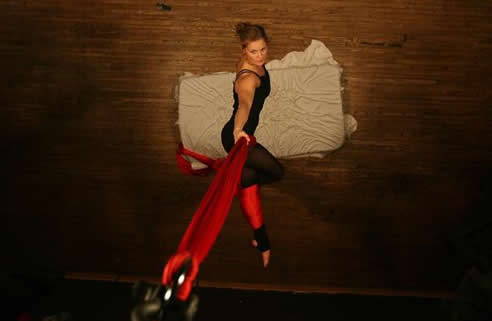Heather Whinnen is a performer and teacher of aerial arts. She’s been practicing ballet since kindergarten and over the years she’s also diligently learned modern dance and circus arts. She began practicing aerial arts ten years ago and has traveled the world performing. She currently lives and works in Seattle, Wa.
Ginna Luck: HI Heather, thank you so much for talking with me. I have so much I want share with our readers. First off, you are an aerial artist. For those of us who are not familiar with this type of art can you describe what it is you do?:
Heather Whinnen: Aerial arts — or more commonly recognized- trapeze/circus arts, are a combination of stunt work, theatricality, finely tuned dance technique and something very difficult to define, pure soul, the expression of living life in extremes, going over the edge, again and again and again and again and again without a moment of repetition. Nothing living can be repeated or created exactly the same twice. Each moment is unique.
GL: How did you get into this line of work?
HW: I got into this line of work through dance and being born part monkey/cat. I started taking ballet classes in kindergarten and have been dancing ever since. I’ve always loved climbing things and being up high. I have a much better view when playing hide-and-go-seek! No one ever thought to look up on the roof! I always got a kick at watching my friends try to find me. There I was above them seeing them looking for me under the shrubbery!
I so loved the view and the challenge of climbing that I would claw my way up the scraggly Ponderosa pines in our neighborhood! Those beasts are all narrow trunk forever and then sprout into a mess of twiggy branches WAY at the top.
I loved playing the firefighter who got to rescue the cat out of the tree. No ladder! Just some swim goggles for the bark that sprinkled and crumbled like tiny avalanches into my eyes.
My parents, being the awesome liberal parents they are, let my sisters, my friends and I drag an old mattress outside as a crash pad for the swing set. We would launch ourselves off the seats into that thing.
I’d spend hours and hours on that swing set. Climbing around in the chains, climbing to the top bar. And I’d practice my ballet moves and poses while swinging.
My father had been a core driller. He made this INDUSTRIAL strength swing set out of thick steal and iron. He plunged that dense swing set poles deep into the earth and made deluxe padded seats out of flat boards covered in vinyl/pleather (plastic leather). That thick padding meant I could swing in the SNOW and my bum wouldn’t freeze! My daddy loved me so much. He thought of everything. I was spoiled with love. I was one of daddy’s little girls. My father passed away in 1996 and that swing set lives in my mind as part of his legacy.
GL:When did you start getting interested in performing as a way of life?
HW: Now that’s the random part in my story that links all the pieces of my childhood monkeyness and adult dancing together.
Here enters, “The Rabbit,” a.k.a, street performer, the rabbit that sent me diving into a wormhole of circus bizarre-i-o-so.
He was wearing green furry leggings and a dapper, bright orange, furry vest.
He was like an urban Sasquatch, a city Satyr, the Pan piper of wild things, wild things like me, who were/are- trapped perhaps- in chaos made of concrete, in a screeching zone of sirens and piercing beeps.
There is Pan, the street performer, looking like no one I’d ever seen in the city before, which is to say, weird. This guy was fantastically weird. This guy was intentional, meticulous magic. This guy could walk in both worlds. He could enter the dimension of otherworldly imagination and come back out for tea in a suit and tie if he wanted to. I sensed it. I knew it. He was a street performer by choice.
And I was entranced.
What a showman! He had a huge cubic metal, (probably aluminum), structure, and a skeleton frame of squares. He was balancing this thing on his chin! He grabbed four people from the crowd, put the cube on their shoulders and proceed to climb up their bodies to the top of the cube where he did a handstand!
I’d never seen anything like it. I had no idea what circus arts were. I had no idea that the extraordinary would one day become an ordinary part of my daily life.
The street performer’s name was Mason. I don’t know anything else about his identity. He disappeared from my life as quickly and magically as he had entered it. But before I lost contact with him he gave me the name and number of Lara Paxton, the founder of a company (that has since dissolved) called Circus Contraption.
I started taking aerial classes with her back in the year 2000 and it’s been a crazy circus ride ever since.
The end.
GL:The life of a circus performer, including an aerialist, seems like it would be a really intense way to live. Does the intensity ever become too much?
HW: No it never becomes too much. I love that aspect. It’s the lifestyle that’s too intense.
GL:What’s the lifestyle?
HW: It requires working 3 or so on call jobs making very little money, being able to function highly even after sleeping a couple hours after a show. It’s very stressful. It’s hard to balance all the different things, like training, rehearsing, teaching and making money. I’m not a seasoned professional, meaning I can’t yet make a living off of just performing,
Some day I hope to start my own company or be a part of a company that I truly respect, that truly inspires me. I will not free lance forever. I hope to be a part of company that infuses modern dance with circus arts, with intense acrobatic physicality and aerial, something with intellectual and emotional depth, not just spectacle.
GL: What does it feel like in those moments when you’re performing and you reach the type of intellectual and emotional depth you aspire to?
HW: For me it’s a sense of ultimate joy, since I’m so high up. I’m sort of transcending daily life. I’m going to my place of bliss. My higher self is waving hello to the audiences” higher self. How common is it in this day and life that people have that kind of connection. I always feel my soul is talking. It’s just a really liberating feeling. I’m transcending all the BS.
One of my favorite performances was at an event called “Smoke Farm.” A fantastic twisted metal sculpture, abstractly shaped like budding vines, was hung 40 feet high or so, in a grove of cedar trees up north in Arlington, WA. Several aerial climbing ropes dangled from the “stems” of the metal sculpture. A group of aerialists and I climb these ropes silently, like creatures of the woods, and “danced” together, hanging there, so high off the ground. This kind of performance is my favorite. Site specific, original/uniquely designed apparatus/art sculptures, original music or no music at all, collaborative, interactive with the “audience,” informal, honest, simple and created and performed without an agenda. This is the kind of art I enjoy doing the most.
GL: I like how you describe yourself as a ‘creature of the woods’. Do you feel like aerial art is very animalistic?
HW: Yes, I guess I do. When I’m performing I shed all the intricacies of being a human being and I get to be some kind of creature. It’s a chance to tap into something mystical.
GL: After an experience like that, do you have a hard time just going back to ‘normal’ life?
HW: I never have a setting where I’m suppose to be normal. I just discovered peanut butter in an eye shadow container. That’s just how I live.
GL: The ‘Smoke Farm’ performance was an example of you favorite kind of work, but what type of jobs do you do most often as an aerialist?
HW: I perform a lot of aerial art/dance for clubs, corporate events, private parties (weddings, birthdays, etc), music festivals and once for a T.V. commercial. When I create work for this kind of thing the objective is to please others. It feels different. I always choreograph and create work that resonates in my soul, hits my own emotional chords, but when I work for money, my art does feel compromised a bit. C’est la vive.
GL: Why do you think this type of art is less fulfilling?
HW:I get frustrated when I have to put on a performance that falls into just looking sexy, which is what a lot of these jobs sort of require — be all gold and have my whole since of worth wrap around my sexuality. But, it’s what pays the bills. I know I’m more diverse then that. And it’s boring for me. It’s frustrating that women have to have these roles.
When I am in this position I have to fight insecurities. I have to be that thing that others want me to be. I’m used to it but it’s a different kind of self. I’ve learned just to be more Zen with life. I have to let go with whatever judgment others may have and just enjoy what I’m doing. If I don’t my performance becomes more of a nerve-racking experience. I start to focus on how I don’t fit the body type, sexy woman. So I go out there and try to just focus on feeling good. I like to instill in every woman a carefree sort of feeling. Don’t worry about it. Love yourself. You’re beautiful.
I love to feel that way myself. I really focus a lot on developing a since of self-love for my body. It’s a very empowering. I try to be an example. All the things that are considered taboo don’t matter to me. I have the eyes of a child. I think of ballet. I never noticed my ballet teacher’s fat on her body. She was just this beautiful loving woman that taught me how to do a pirouette.
GL: How come you are drawn to aerial arts?
HW: My life, like my art, are a pendulum of the fantastic and the mundane. What most people would find exhausting and quite unusual is the norm for me. What is strange for most is my common ground. Extremes that would overwhelm the vast majority are my daily territory. This is simply how the stars aligned for me. It was/is my destiny to have “weird” extraordinary, powerful, INTENSE things happen to me. It’s in my genetics somehow. It’s my fate. And a great deal of the time, it’s very painful and very hard to navigate through. Aerial art helps me through this intensity. It is a vehicle that expresses to others visually what it is like “To be Heather Whinnen,” to have a life of extreme polarity. In this way I am silently communicating and connecting with others. I am reaching out and being received in a most receptive and appreciative way.
GL: Why do you think it was/is your destiny to have “weird” extraordinary, powerful, INTENSE things happen to you?
HW: I don’t know why. It’s just how the cards laid out for me. I guess I’ve been shaped by experiences. I don’t know. My whole upbringing was always intense and traumatic. That defiantly had a huge impact on how I deal with life. I have a very fierce survival instinct. If I am going to make it in life and as an artist I have to be very determined and intense which sometimes leads to the weird and extraordinary.
GL: Can you describe what it feels like to be an aerialist?
HW: Imagine being really high, wrapping loops and knots around yourself. After you set up in this wrap you let go and the knot synchs down really hard on the spine and creates bruises everywhere. I have to have a certain tolerance. Inflecting pain on the physical body somehow releases any kind of emotional hurt. After you do it for the first time you’ll have rope or fabric burns or bruises. After awhile you stop bruising and the pain isn’t so intense.
GL: Why is it that you just stop bruising?
HW: I think that light intricate adjusting helps support your body better. I someone know innately how to not put so much pressure on certain parts of my body. I learn how to relax the parts of my body that I’m not using. This is what makes everything look good. I don’t pick up choreography quickly, so in the beginning my muscles have to work on getting my body set up correctly. In time I get stronger. Then I have to get rid of all of the tension so I can be strong and dance.
GL: You mentioned how ‘inflecting pain on the physical body somehow releases any kind of hurt’. How else does your art aid you emotionally.
HW: In brief: My art is my therapy. Not only does it help me make meaningful connections to others, it also offers me a sense of personal control, a guardian, a fierce warrior, a tool- like a sword- that cuts into emotional pain by embracing physical pain. Aerial hurts! It is brutally painful, very hard on the body. It’s incredibly dangerous. When I take that rope or metal bar or fabric in my hand I am saying, “Look here. I am doing this willfully. The pain that is about to be inflicted on my body is my choice and I can handle it.” My art is very empowering.
GL: Have you ever been seriously injured performing?
HW: I’ve had serious neck and back breaks. I had a hairline fracture in both f my feet. For a long time I had to wrap them in ice. I still have to work after all this.
GL: How can you work with a broken back?
HW: There is something called the spinous process that protects the spine. It split open. But I was still able to move around. It wasn’t like I broke it and I couldn’t move. It really sucks now. It didn’t hurt the first year it happened but as time goes by it hurts more and more. I have lots of scare tissue that causes it to ache. But I’ve acclimated to the pain.
GL: It seems to me this would almost be too much to bear.
HW: In this profession it’s common to have these types of injuries. Plus, aerial art is not something I choose to do it’s something I have to do. I have so much more that I want to accomplish with this form of art. It’s a part of me and helps me in so many ways, so the pain is outweighed by the joy and just pure pleasure I get from performing and teaching.
GL: Can you tell us when your next performance is so that we can all come see you.?
HW: I’ll be a part of the New Years show at Emerald City Trapeze Arts in SODO.
GL: Thanks Heather. I wish you all the best in your future as an aerial artist. It was really a pleasure talking to you.
HW: Thank you Ginna for this opportunity to reflect and reminisce! It’s been really fun, brought back many fond memories and has actually helped me understand why on earth I do what I do. At this point in my life I often wonder and doubt. My dreams have many times been squashed and I am not at all where I hoped to be. But still, I’m here and I’m not ready to let go. There will be a time when I am FULL TIME or I’ll die trying. And as far as I’m concerned, it’s a pretty good way to go. Yah, I’m living the dream.
